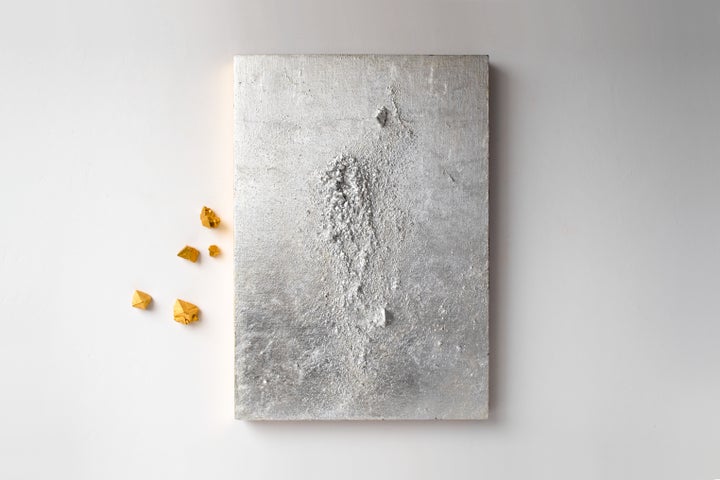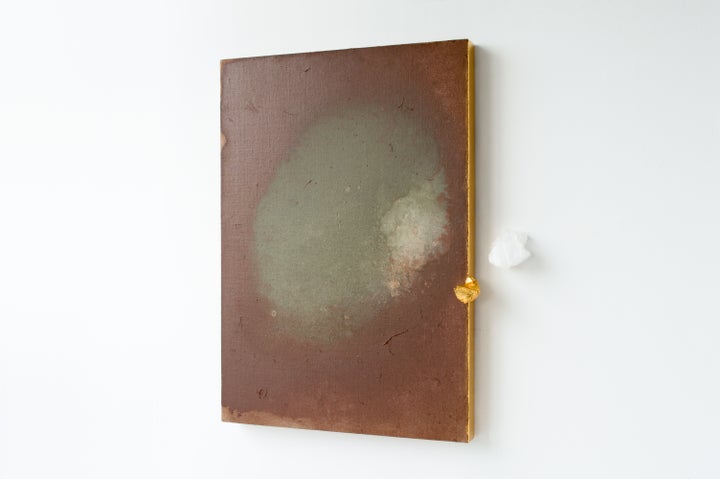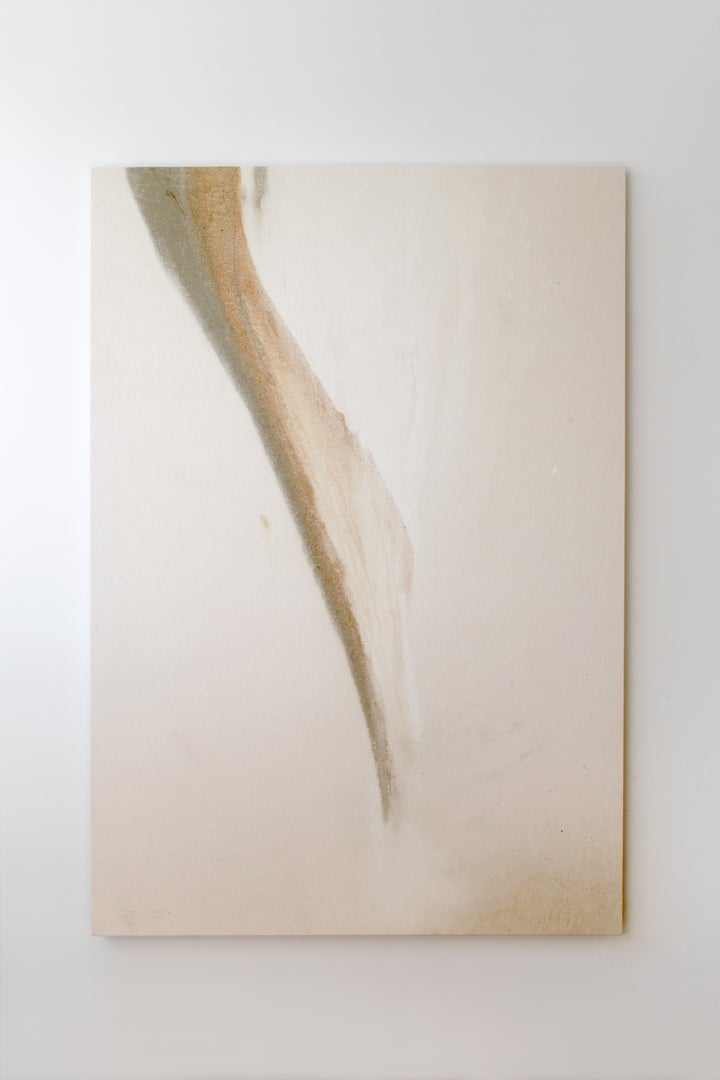I recently caught up with Shinji Turner-Yamamoto before he left for a residency in Alaska. The artist’s work is in direct dialogue with the natural world and he often incorporates elements of nature into his creation process. Turner-Yamamoto has lived and made art on three continents and I was curious to learn about the impact different environments and cultures have had on his work. His work was featured in the recent two-person exhibition Substance and Increase at Sapar Contemporary in New York City.

Constellaria #13, 2017
Ca. 450-million-year-old Ordovician fossil dust and shale, ca. 440-million-year-old Silurian volcanic ash, cultured crystals grown on Ordovician fossil fragments, 24kt gold and silver leaf, gesso, clay bole, animal glue, dragon's blood, natural resin, mixtion, raw linen canvas, wood panel. 72 x 71 x 7cm - 28.5 x 28 x 3 in
You’re from Japan and went to art school in Kyoto, later lived in Italy for 11 years, and now live in Ohio. How does your experience in different cultures affect your work?
Most important, the main language in which I write about my work shifted first from Japanese to Italian, and then from Italian to English. This forced me to learn how to articulate my thoughts thoroughly. Also, whether I think that I’m writing an “artist statement” or a “dichiarazione di poetica” changes my mindset.
To see, feel, or understand things, cultural distance helps. I think I now understand Japanese culture very differently than before, including the language.
Only after several years of living In Italy, while working on one of my abstract paintings, did I suddenly begin seeing a Japanese landscape, a sort of air/atmosphere recognizable and familiar to me. I continued to ponder and wonder about that air I felt and still can feel. Was it the essence of a culture? I don’t know…The series of works I created at that time were entitled “AËR,” air in Latin. And I think I am still working on this through painting.
When I visited one of “U Jardinu” (garden) in Pantelleria Island, Sicily—a very windy place—I felt I understood the meaning of the garden and of nature in western culture. Entering inside this protected circular stone walled structure, I saw and smelled a tree that bore fruits of both orange and lemon…there was suddenly no wind, and in that quiet only the intense smell of the essence of citrus. This experience became one of the inspirations for using nature as an element in my work within an artificial structure. Painting itself is also an extremely artificial thinking platform. That kind of neutral flat surface and pictorial space is nonexistent in nature.

Constellaria #11, 2017
Ca. 450-million-year-old Ordovician fossil dust and shale, ca. 440-million-year-old Silurian volcanic ash, cultured crystals grown on Ordovician fossil fragments, 24kt gold leaf, gesso, clay bole, animal glue, natural resin, mixtion, raw linen canvas, wood panel. 72 x 60 x 7.5 cm - 28.5 x 23.5 x 3 in
I’m curious about the idea of history, both of materials and places, in your work. Could you tell me about your interest in history?
Currently geological history and its timescale inspire me more than anything else. This may be because I live in Cincinnati, which literally sits on the c.a. 450-million-year-old Ordovician rocks, where there are many road cuts that reveal unbelievable strata. When I stand in front of strata of the height of a 20-story building comprised of several-million-years of sedimentary rock layers, I feel awe. It is truly inspiring.
In general, I use materials I collect as the main elements in my work. Even when I work with a small one-inch fossil fragment, knowing the fragment’s provenance, it changes my perspective.

Sidereal Silence: Irish Study #9, 2016
Ca. 450-million-year-old Ordovician fossil dust, turf ash, calcium carbonate, magnesium silicate, mica, rainwater, nikawa glue, natural resin, raw cotton canvas. 184 x 127 x 4 cm | 72 x 50 x 1.5 in
You often work directly with the land in different locations. Do you think about yourself as being in conversation with Land Artists like Michelle Stuart and Robert Smithson?
When I was in the Gobi Desert for the MONGOLIA 360° International Land Art Biennial, I felt so disoriented. It was a great experience to sense our physical smallness, to feel lost in a vast landscape, to gain a larger perspective of our place in the universe. As Robert Smithson emphasized, we artists need to “explore the pre- and post- historic mind and go into places where remote futures meet remote pasts.”
On the other hand, while I consider James Turrell’s Skyspace, for example, one of greatest contemporary art works, I still experience more inspiration from the 2000-year-old oculus of the Pantheon, which is probably where Turrell’s idea came from. When I was living in Rome I visited there very frequently, especially when there was a bad weather. I was especially fascinated by the rain inside the Pantheon. I find rainfall in that manmade space sublime.
Recently I visited a mountaintop removal site in West Virginia. There is a sad violence that comes from our need for energy. I also find a similar unnecessary disturbance of nature in some Land Art, something I try to avoid in my artistic practice as much as possible.

Sidereal Silence: Irish Study #5, 2016
Ca. 450-million-year-old Ordovician fossil dust, turf ash, calcium carbonate, magnesium silicate, mica, rainwater, nikawa glue, natural resin, raw cotton canvas. 178 x 122 x 4 cm | 70 x 48 x 1.5 in
For your Sidereal series you put canvases outside, opening them up to wind and rain, all of the outdoor’s elements and inhabitants. The product is unpredictable and the canvases are left vulnerable. In contrast or harmony with that, I found the effect of the pieces to be very calming, and somewhat transportive. Can you talk a bit about this process and these works?
The Irish say that in Ireland there are four seasons in a day—and it is quite true—almost every day there will be rain and also sunny moments. It worked perfectly with my creative process.
I strung unstretched canvases up in temporary outdoor studios (cottage ruins on the southwest coast of Ireland). After the rain totally soaked the canvases, I would begin working.
I work with water for several reasons. It is at first I need water as the main solvent for my painting. I especially prefer using rainwater because of its celestial origin. It falls together with some of interstellar cosmic dust. It is “the” water to me.
As you used the word vulnerable, some paintings I created there, existed only a few minutes to hours, only to be washed away by strong rain. There was also the unpredictable movement of the unstretched canvas in the wind. I was using relatively thin canvas, and they were ripped several times by strong wind... Alternately, an unexpected wind gust created that line that you saw in Sidereal Silence: Irish Study #9 in the Sapar Contemporary exhibition.

Pentimenti #56, 2017
crystals grown on 19th century Holy Cross Church plaster fragment, 24kt gold leaf, dragon's blood, natural resin. 11 x 19 x 16 cm - 4 x 7.5 x 6.5 in
For your Pentimenti series you do such things as grown a crystal on top of a piece of coal. With these works and the Sidereal series there is a combination of the manmade and the natural. How do you think about these two in relation to one another, particularly in this age of technology?
I’m interested in blurring the boundary between these two. When I created a site-specific installation with a Banyan Tree at Sanskriti Foundation, New Delhi, India, for example, many visitors, including artists, mentioned that there was a moment of doubt if what they were seeing was manmade or a natural phenomenon. We are part of nature, part of the universe, yet, what we do is artificial and anthropocentric—geologically we are in the Anthropocene age that began c.a. 10,000 years ago with the end of the last glacial period. In my artistic practice, I try to eliminate artificiality from the creative process at a certain stage by inviting nature’s collaboration in order to establish a stronger connection to the universe.
I recently saw your two-person show at Sapar Contemporary. How do you see your work interacting with Gabriela Albergaria’s?
As the curator Gregory Volk wrote, I think what unites us “is not a shared aesthetic but instead a shared sensibility” toward nature and the universe. Yet, we both use raw earth substances, and I think the actual tonal echoes did happen in the gallery space, especially through these earth pigments from many parts of the world.
To see more of Turner-Yamamoto’s work, visit his website. Works by the artist are always available to view on request at Sapar Contemporary. Selected works from the Pentimenti series will be on view in: “Alchemy: Transformations in Gold,” Akron Art Museum (October 7, 2017 - January 21, 2018). The exhibition was organized by the Des Moines Art Center.